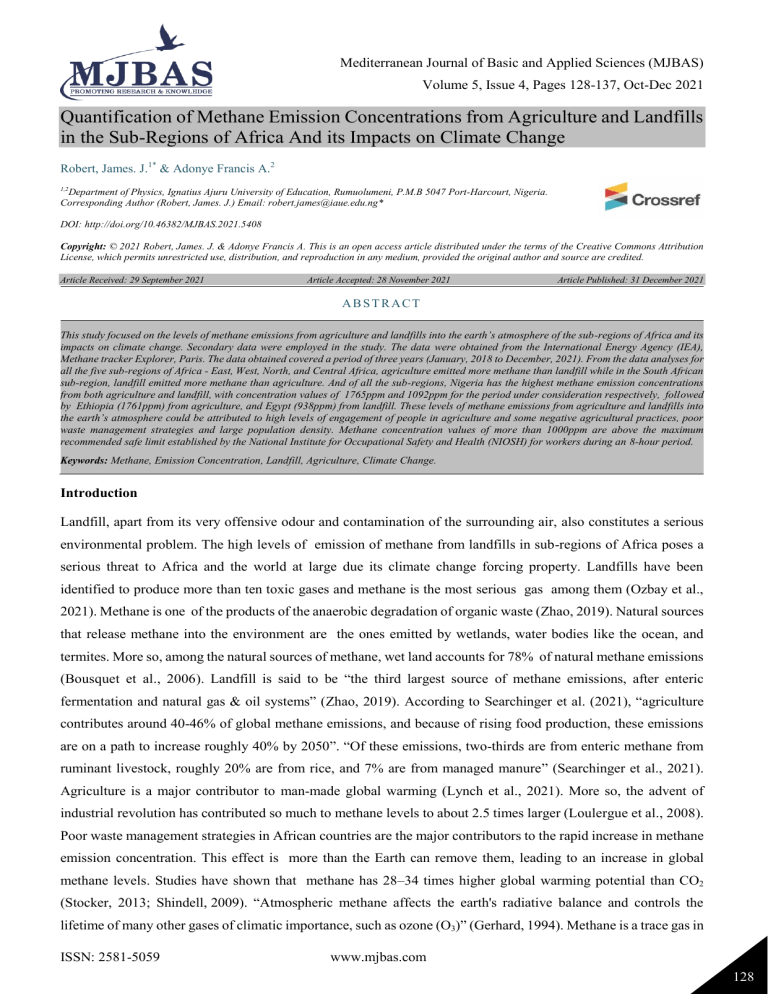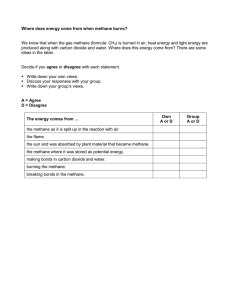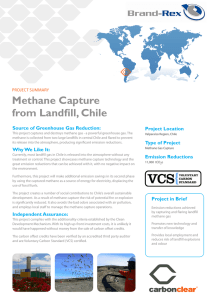Quantification of Methane Emission Concentrations from Agriculture and Landfills in the Sub-Regions of Africa And its Impacts on Climate Change
advertisement

Mediterranean Journal of Basic and Applied Sciences (MJBAS) Volume 5, Issue 4, Pages 128-137, Oct-Dec 2021 Quantification of Methane Emission Concentrations from Agriculture and Landfills in the Sub-Regions of Africa And its Impacts on Climate Change Robert, James. J.1* & Adonye Francis A.2 1,2 Department of Physics, Ignatius Ajuru University of Education, Rumuolumeni, P.M.B 5047 Port-Harcourt, Nigeria. Corresponding Author (Robert, James. J.) Email: robert.james@iaue.edu.ng* DOI: http://doi.org/10.46382/MJBAS.2021.5408 Copyright: © 2021 Robert, James. J. & Adonye Francis A. This is an open access article distributed under the terms of the Creative Commons Attribution License, which permits unrestricted use, distribution, and reproduction in any medium, provided the original author and source are credited. Article Received: 29 September 2021 Article Accepted: 28 November 2021 Article Published: 31 December 2021 ABSTRACT This study focused on the levels of methane emissions from agriculture and landfills into the earth’s atmosphere of the sub-regions of Africa and its impacts on climate change. Secondary data were employed in the study. The data were obtained from the International Energy Agency (IEA), Methane tracker Explorer, Paris. The data obtained covered a period of three years (January, 2018 to December, 2021). From the data analyses for all the five sub-regions of Africa - East, West, North, and Central Africa, agriculture emitted more methane than landfill while in the South African sub-region, landfill emitted more methane than agriculture. And of all the sub-regions, Nigeria has the highest methane emission concentrations from both agriculture and landfill, with concentration values of 1765ppm and 1092ppm for the period under consideration respectively, followed by Ethiopia (1761ppm) from agriculture, and Egypt (938ppm) from landfill. These levels of methane emissions from agriculture and landfills into the earth’s atmosphere could be attributed to high levels of engagement of people in agriculture and some negative agricultural practices, poor waste management strategies and large population density. Methane concentration values of more than 1000ppm are above the maximum recommended safe limit established by the National Institute for Occupational Safety and Health (NIOSH) for workers during an 8-hour period. Keywords: Methane, Emission Concentration, Landfill, Agriculture, Climate Change. Introduction Landfill, apart from its very offensive odour and contamination of the surrounding air, also constitutes a serious environmental problem. The high levels of emission of methane from landfills in sub-regions of Africa poses a serious threat to Africa and the world at large due its climate change forcing property. Landfills have been identified to produce more than ten toxic gases and methane is the most serious gas among them (Ozbay et al., 2021). Methane is one of the products of the anaerobic degradation of organic waste (Zhao, 2019). Natural sources that release methane into the environment are the ones emitted by wetlands, water bodies like the ocean, and termites. More so, among the natural sources of methane, wet land accounts for 78% of natural methane emissions (Bousquet et al., 2006). Landfill is said to be “the third largest source of methane emissions, after enteric fermentation and natural gas & oil systems” (Zhao, 2019). According to Searchinger et al. (2021), “agriculture contributes around 40-46% of global methane emissions, and because of rising food production, these emissions are on a path to increase roughly 40% by 2050”. “Of these emissions, two-thirds are from enteric methane from ruminant livestock, roughly 20% are from rice, and 7% are from managed manure” (Searchinger et al., 2021). Agriculture is a major contributor to man-made global warming (Lynch et al., 2021). More so, the advent of industrial revolution has contributed so much to methane levels to about 2.5 times larger (Loulergue et al., 2008). Poor waste management strategies in African countries are the major contributors to the rapid increase in methane emission concentration. This effect is more than the Earth can remove them, leading to an increase in global methane levels. Studies have shown that methane has 28–34 times higher global warming potential than CO2 (Stocker, 2013; Shindell, 2009). “Atmospheric methane affects the earth's radiative balance and controls the lifetime of many other gases of climatic importance, such as ozone (O3)” (Gerhard, 1994). Methane is a trace gas in ISSN: 2581-5059 www.mjbas.com 128 Mediterranean Journal of Basic and Applied Sciences (MJBAS) Volume 5, Issue 4, Pages 128-137, Oct-Dec 2021 the atmosphere. Heilig (1994) opined that “The role of methane in the chemistry of the atmosphere is complex and still not fully understood”. “Many trace gases are removed by reaction with hydroxyl radical and deposition in rainfall or dryfall at the Earth's surface” (Schlesinger & Bernhardt, 2020). This process serves as the largest sink for carbon. The presence of water vapour in the stratosphere is partly contributed by methane, which also affects stratospheric ozone and climate (Solomon, 2010). “The recent observation that global methane concentrations have begun increasing, after a decade of static or decreasing emissions in the late 1990s to 2007, has renewed interest in pinpointing the causes of global methane trends” (Barbara, 2014). “The rate of increase observed during the last few decades is 1–2% per year” (Gupta1 & Bhatia, 2019). Methodology Study Area: The second largest continent by size and population, after Asia is Africa. According to Google Art and Culture (n.d), “at about 30.3 million km2 (11.7 million square miles) including adjacent islands, it covers 6% of Earth's total surface area and 20% of its land area”. The greater part of the continent of Africa is said to be in the tropics, with the exception of the Western Sahara that is located above the tropic of Cancer, in the northern temperate zone (https://en.wikipedia.org/wiki/Portal:Africa). Africa is a continent of high variable climate (Lotus Arise, 2020 August 19). The UN Intergovernmental Panel on Climate has also identified Africa as the continent most vulnerable to climate change (https://en.wikipedia.org/wiki/Portal:Africa). Map of Africa, the study area is shown in figure 1. Figure 1. Map of Africa and its sub-regions Data Acquisition and Analyses Secondary data were employed in this study. The data were obtained from the International Energy Agency (IEA), Methane tracker Explorer, Paris. The data obtained covered a period of three years (January, 2018 to December, 2021). The data collected were analyzed using bar charts and scatter plots. ISSN: 2581-5059 www.mjbas.com 129 Mediterranean Journal of Basic and Applied Sciences (MJBAS) Volume 5, Issue 4, Pages 128-137, Oct-Dec 2021 Results and Discussion Figures 2, 3, 4, 5, and 6 are bar-charts representing methane (CH4) emission concentrations from agriculture and landfills, while figure 7 to16 are scatter plots showing the relationship between relative humidity and methane (CH4) emission concentrations, and also the relationship between temperature and methane (CH4) emission concentrations for the five sub-regions of Africa respectively. Uganda Figure 2. Methane (CH4) Emission Concentrations for East African Region In figure 2 the blue bar represents methane emissions from agriculture while the red bar represents emissions from landfills. Ethiopia has the highest methane concentration in both landfill(456 ppm) and agriculture (1761ppm) followed by Kenya. This could possibly be because Ethiopia engages more in agricultural activities and also generates enormous waste than any other country in the region. It could also be attributed to having the poorest waste management strategies. Countries like Congo and Eritrea have limited amounts of methane concentrations from agriculture and landfill. Figure 3. Methane (CH4) Emission Concentrations for West African Region ISSN: 2581-5059 www.mjbas.com 130 Mediterranean Journal of Basic and Applied Sciences (MJBAS) Volume 5, Issue 4, Pages 128-137, Oct-Dec 2021 Figure 3 is the bar chart for methane (CH4) emission concentration for West African region. Here, Nigeria has the highest methane emission concentration from agriculture (1765ppm) and waste (1092 ppm) followed by Niger with (712 ppm) and (194 ppm) respectively. Gambia, Guinea Bissau and Liberia have the smallest amount of methane concentrations from agriculture and waste. Figure 4. Methane (CH4) Emission Concentrations for North African Region Figure 4 represents methane (CH4) emission concentration for the North African region. Sudan has the highest methane concentration (1412 ppm) from agriculture while Egypt has the highest methane concentration (938 ppm) from landfills. Libya has the smallest methane emission concentration from agriculture and landfills in the North African region. Figure 5. Methane (CH4) Emission Concentrations for South African Region Methane (CH4) emission concentration from agriculture and landfills for the South African region are shown in figure 5. In figure 5, Botswana has the highest methane emission concentration of (1122 ppm) from landfill while South Africa has the highest methane emission concentration of (724 ppm) from agriculture. ISSN: 2581-5059 www.mjbas.com 131 Mediterranean Journal of Basic and Applied Sciences (MJBAS) Volume 5, Issue 4, Pages 128-137, Oct-Dec 2021 Figure 6. Methane (CH4) Emission Concentrations for Central African Region Methane (CH4) emission concentration for the Central African region is shown in figure 6. A critical at look at figure 6 shows that Chad has the highest methane emission concentration of (1,331ppm) from agriculture followed by Angola with (374ppm) while Cameroon has the highest methane emission concentration of (225ppm) from landfill followed by Angola with (183ppm). Equatorial Guinea and Gabon have the smallest methane emission concentration from both agriculture and landfill. East African Region Figure 7. Relative Humidity Vs CH4 Emission Concentration for East African Region Figure 7 shows a weak positive correlation between the relative humidity and methane emission concentration. Figure 8. Temperature Vs CH4 Emission Concentration for East Africa Region ISSN: 2581-5059 www.mjbas.com 132 Mediterranean Journal of Basic and Applied Sciences (MJBAS) Volume 5, Issue 4, Pages 128-137, Oct-Dec 2021 In figure 8, the relation between temperature and methane emission concentration is a weak negative correlation. West African Region Figure 9. Relative Humidity Vs CH4 Emission Concentration for West African Region Figure 9 indicates a weak negative correlation between relative humidity and methane emission concentration. Figure 10. Temperature Vs CH4 Emission Concentration for West African Region Figure 10 indicates a weak positive correlation between temperature and methane emission concentration. North African Region Figure 11. Relative Humidity Vs CH4 Emission Concentration for North African Region Figure 11 shows a weak negative between relative humidity and methane emission concentration. ISSN: 2581-5059 www.mjbas.com 133 Mediterranean Journal of Basic and Applied Sciences (MJBAS) Volume 5, Issue 4, Pages 128-137, Oct-Dec 2021 Figure 12. Temperature Vs CH4 Emission Concentration for North African Region Figure 12 indicates a negative correlation between relative humidity and methane concentration. South African Region Figure 13. Relative Humidity Vs CH4 Emission Concentration for South African Region In figure 13, relative humidity and methane emission concentration has a negative correlation. Figure 14. Temperature Vs CH4 Emission Concentration for South African Region In figure 14, temperature and methane emission concentration has a strong positive correlation. ISSN: 2581-5059 www.mjbas.com 134 Mediterranean Journal of Basic and Applied Sciences (MJBAS) Volume 5, Issue 4, Pages 128-137, Oct-Dec 2021 Central African Region Figure 15. Relative Humidity Vs CH4 Emission Concentration for Central African Region Figure 15 shows a negative correlation between relative humidity and methane emission concentration. Figure 16. Temperature Vs CH4 Emission Concentration for Central African Region In figure 16, temperature and methane emission concentration have a weak positive correlation between them. Conclusion From the data analyses for all the five sub-regions of Africa, the East, West, North, and Central Africa, agriculture emitted more methane than landfill while in the South African sub-region, landfill emitted more methane than agriculture. And of all the sub-regions, Nigeria has the highest methane emission concentrations from both agriculture and landfill, with concentration values of 1765ppm and 1092ppm respectively, followed by Ethiopia (1761ppm) from agriculture, and Egypt (938ppm) from landfill. This level of methane emissions from agriculture and landfill into the earth’s atmosphere could be attributed to high levels of engagement in agriculture and some negative agricultural practices, practices, poor waste management strategies and large population density. Methane concentration values of more than 1000ppm is above the maximum recommended safe limit established by the National Institute for Occupational Safety Health (NIOSH) for workers during an 8-hour period. ISSN: 2581-5059 www.mjbas.com 135 Mediterranean Journal of Basic and Applied Sciences (MJBAS) Volume 5, Issue 4, Pages 128-137, Oct-Dec 2021 Declarations Source of Funding This research did not receive any grant from funding agencies in the public, commercial, or not-for-profit sectors. Competing Interests Statement The authors declare no competing financial, professional and personal interests. Consent for publication Authors declare that they consented for the publication of this research work. References Barbara, J. (2014). Toward a better understanding and quantification of methane emissions from shale gas development. Available Online at: https://www.pnas.org. Bousquet, P., Tyler, S.C., Peylin, G.R., Van Der Werf, C., Prigent, D.A., Hauglustaine, E.J., Dlugokencky, J.B., Miller, P., Ciais, J., White, L.P., & Steele, M. (2006). Contribution of anthropogenic and natural sources to atmospheric methane variability. Nature, 443(7110): 439-443. Google Art and Culture (n.d). Africa. https://artsandculture.google.com/entity/africa/m0dg3n1?hl=en. Gupta, P., and Bhatia, K.R. (2019). Quantitative analysis of methane gas emission from municipal solid waste in Jabalpur. International Research Journal of Engineering and Technology, 6(7): 1790-1795. Heilig, G.K. (1994). The Greenhouse Gas Methane (CH4): Sources and sinks, the impact of population growth, possible interventions. Population and Environment, 16(2): 109-137. Lotus Arise (2020). Africa-World Geography for UPSC IAS (NOTE). https://lotusarise.com/africa-world- geography-for-upsc/. Loulergue, L., Thomas, F.S., Dominique, R., Jean-Marc, B., Bénédicte, L., Thomas, B., Valérie, M., & Jérôme, C. (2008). Orbital and millennial-scale features of atmospheric CH4 over the past 800,000 years. Nature, 453(719): 383-386. Lynch, J., Cain, M., Frame, D., & Pierrehumbert, R. (2021). Agriculture's contribution to climate change and role in mitigation is distinct from the predominantly fossil CO2-emitting sector. Frontiers in Sustainable Food Systems, 4. doi: 10.3389/fsufs.2020.518039. Ozbay, G., Jones, M., Gadde, M., Isah, S., & Attarwala, T. (2021). Operation of effective landfills with minimal effects on the environment and human Health. Journal of Environmental and Public Health. doi: https://doi. org/10.1155/2021/6921607/. Searchinger, T., Herrero, M., Yan, X., Wang, J., Dumas, P., & Beauchemin, K., Kebreab, E. (2021). Opportunities to Reduce Methane Emissions from Global Agriculture, Princeton University. ISSN: 2581-5059 www.mjbas.com 136 Mediterranean Journal of Basic and Applied Sciences (MJBAS) Volume 5, Issue 4, Pages 128-137, Oct-Dec 2021 Shindell, D.T. (2009). Improved attribution of climate forcing to emissions. Science, 326(5953): 716-718. Solomon, S. (2010). Contributions of stratospheric water vapor to decadal changes in the rate of global warming. Science, 327(5970): 1219-1223. Stocker, T. (2013). Climate change: The physical science basis: Technical summary. Cambridge University Press, New York. Schlesinger, W.H., & Bernhardt, E.S. (2020). The atmosphere. Biogeochemistry, Pages 51-97. doi: 10.1016/B9780-12-814608-8.00003-7. Zhao, H. (2019). Methane emissions from landfills. M.S. in Earth and Environmental Engineering. Fu Foundation School of Engineering and Applied Science, Columbia University. https://gwcouncil.org/wp-content/uploads/ 2019/06/Methane-Emissions-from-Landfills-Haokai-Zhao.pdf. ISSN: 2581-5059 www.mjbas.com 137



